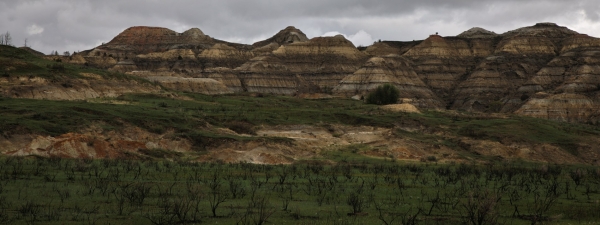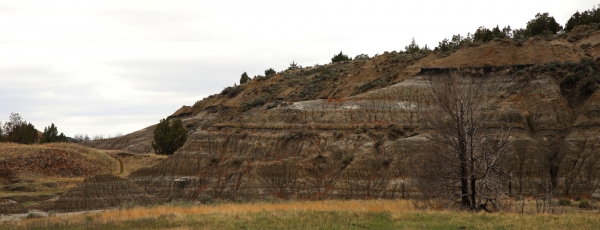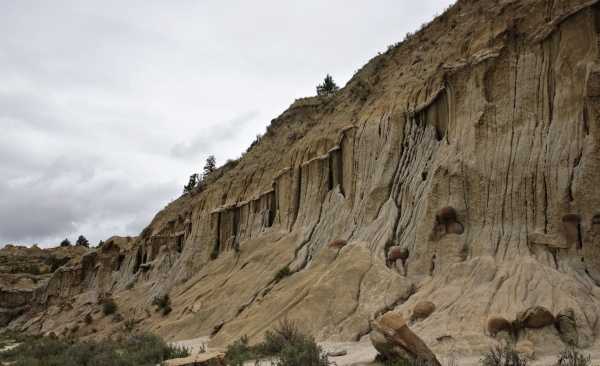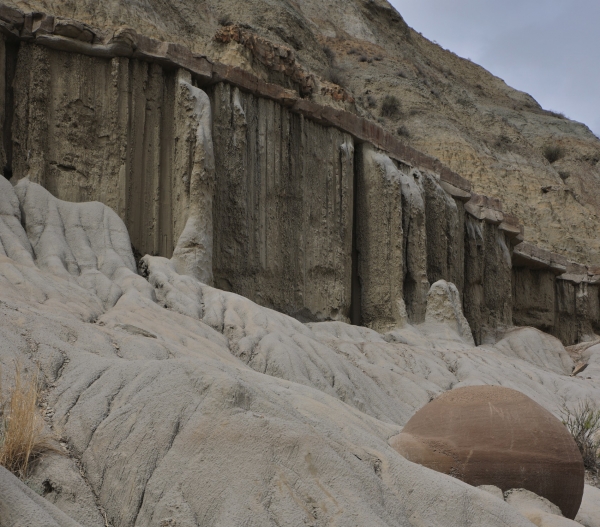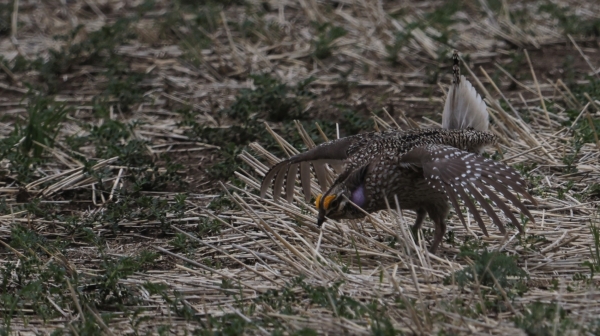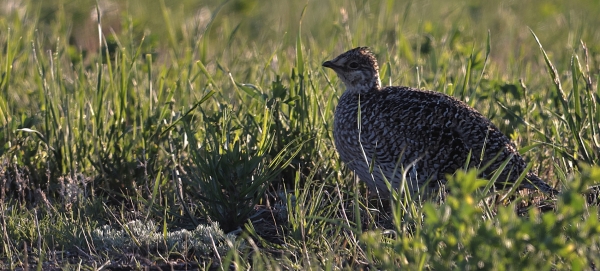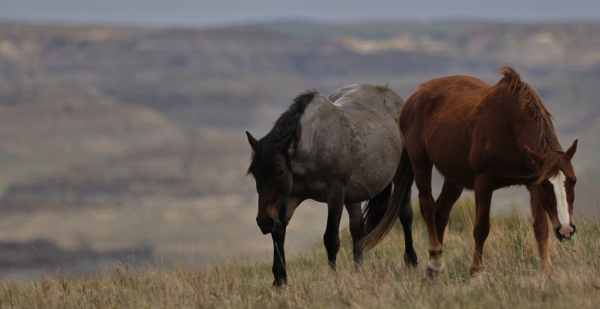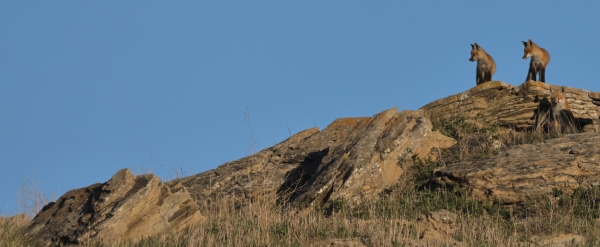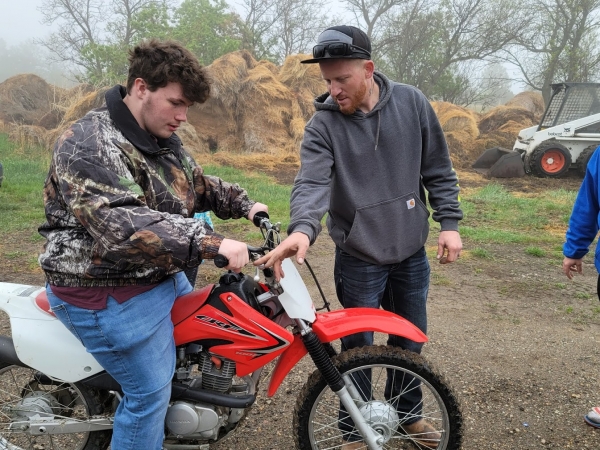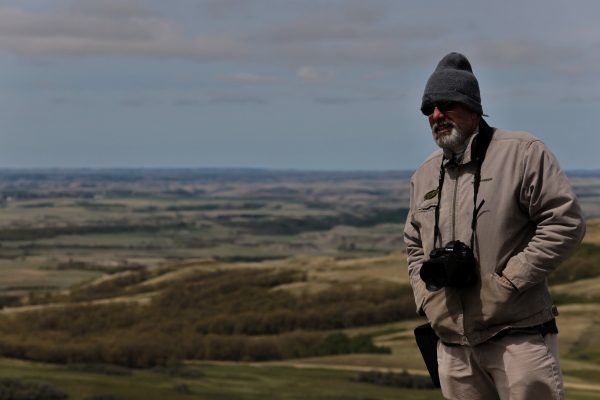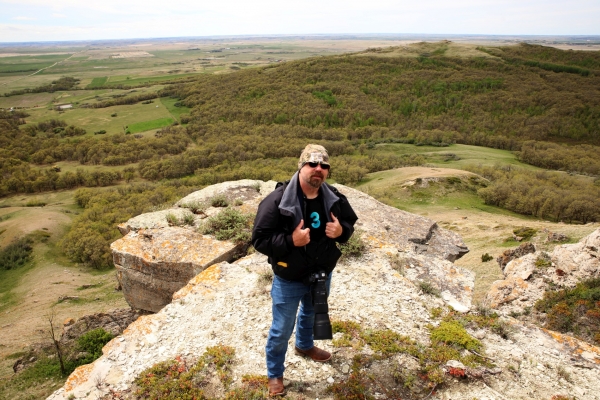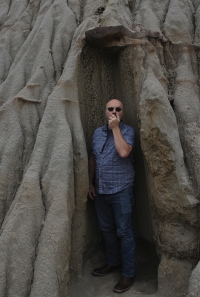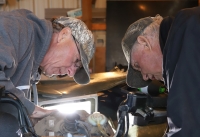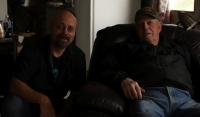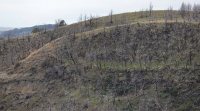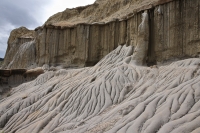Good Memories from the Badlands

 Around three decades had passed since I had been back to Killdeer in Western North Dakota. Since that time, I always dreamed of getting back up there to stomp around the countryside that had mesmerized me as a young man. The place had developed almost a mystical place in my heart as I grew up hearing about all the adventures my dad had growing up there. The brief time I spent there as a teenager stamped a love for Killdeer into my heart, and I always wanted to get back up there with Dad and my kids. Dad left the world before I could do that with him, but I finally got a chance to take my wife and youngest son.
Around three decades had passed since I had been back to Killdeer in Western North Dakota. Since that time, I always dreamed of getting back up there to stomp around the countryside that had mesmerized me as a young man. The place had developed almost a mystical place in my heart as I grew up hearing about all the adventures my dad had growing up there. The brief time I spent there as a teenager stamped a love for Killdeer into my heart, and I always wanted to get back up there with Dad and my kids. Dad left the world before I could do that with him, but I finally got a chance to take my wife and youngest son.
It was at the family farm in the Killdeer Mountains that my uncle Gene Schwartzenberger gave us our first camera, and my lifelong love of photography began. I was excited to take thirty years of experience and new photo equipment up there and chronical some of the places, people and creatures that make the place special to me. Some of the people I would have liked to see are long gone, and some vistas have changed; but just like when I was younger, it was an awesome trip that ended too soon. Killdeer is such a wonderful place full of amazing people.
The adventure didn’t start exactly as I expected. All my younger visits were later in the summer, filled with blue-spotted skies and warm sunshine. I had expected it to already be warm in the last week of May; instead, we started with cold, wet fog. For the first day, we could not see more than a couple hundred yards—and you would never know how grand the landscape is if that was your only experience.
Killdeer
Although the little town of Killdeer has its charm, for me it is the countryside around it and the Killdeer Mountains that makes the place so special. I spent little time in town during this trip. Most was spent at the farm, countryside, or my cousin Delwin’s home.
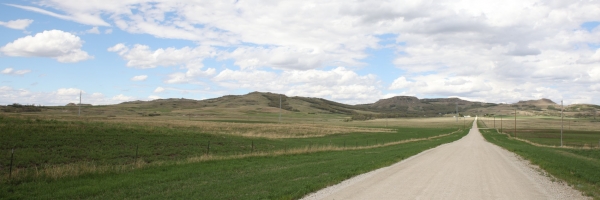 When we first drove up the road leading to the farm, I had to stop a mile away and take a photo of the farm and mountains behind it. It’s a scene I knew well because Dad loved painting that landscape. Old memories of my parents filled my mind, and I felt a kind of happy sadness. It’s so sad to lose the people you love—but the memories of your times together are always warm and happy.
When we first drove up the road leading to the farm, I had to stop a mile away and take a photo of the farm and mountains behind it. It’s a scene I knew well because Dad loved painting that landscape. Old memories of my parents filled my mind, and I felt a kind of happy sadness. It’s so sad to lose the people you love—but the memories of your times together are always warm and happy.


 Overall, the landscape is very much like I remember it. There are a few more houses than I remember. The main change is the number of oil rigs that have popped up over the years. As my uncle Jim and cousin Arlin explained, the development of fracking technology finally made the extraction of the oil in shale profitable. Oil rigs were always around, but now they seem to be everywhere. Almost everywhere you look you’ll see some flames of natural gas acting like beacons. It certainly created a boom for the economy; it’s also taken away a little bit of the remote wildness of the area.
Overall, the landscape is very much like I remember it. There are a few more houses than I remember. The main change is the number of oil rigs that have popped up over the years. As my uncle Jim and cousin Arlin explained, the development of fracking technology finally made the extraction of the oil in shale profitable. Oil rigs were always around, but now they seem to be everywhere. Almost everywhere you look you’ll see some flames of natural gas acting like beacons. It certainly created a boom for the economy; it’s also taken away a little bit of the remote wildness of the area.


Badlands
 The Badlands are a unique and beautiful cornucopia of geology and wildlife. While many places in the world are called badlands, the badlands of Western North Dakota were formed by erosion, in part by the Little Missouri River. Several sections of this are now preserved in the Theodore Roosevelt National Park. The landscape is simply mesmerizing, and if you every get a chance to visit the area west of Killdeer, you will capture vistas that will stay in your imagination for the rest of your life.
The Badlands are a unique and beautiful cornucopia of geology and wildlife. While many places in the world are called badlands, the badlands of Western North Dakota were formed by erosion, in part by the Little Missouri River. Several sections of this are now preserved in the Theodore Roosevelt National Park. The landscape is simply mesmerizing, and if you every get a chance to visit the area west of Killdeer, you will capture vistas that will stay in your imagination for the rest of your life.
Wildlife
 As the weather was colder and wetter than normal at the start of our visit, I was worried I wouldn’t get many animal photos. But the days did clear and the sun did come out, so I was able to get some photos of the local wildlife. Even more exciting for me was seeing my youngest son Hayden finally show a little interest in getting some photos; I don’t think he’s a shutter bug quite yet, but the joy in seeing him look around and pull out his phone to catch a bison or prairie dog did make me smile. When he asked to use one of my larger cameras, I had to force myself not to look too excited.
As the weather was colder and wetter than normal at the start of our visit, I was worried I wouldn’t get many animal photos. But the days did clear and the sun did come out, so I was able to get some photos of the local wildlife. Even more exciting for me was seeing my youngest son Hayden finally show a little interest in getting some photos; I don’t think he’s a shutter bug quite yet, but the joy in seeing him look around and pull out his phone to catch a bison or prairie dog did make me smile. When he asked to use one of my larger cameras, I had to force myself not to look too excited.
The experience was a little new for me too, as this was my first real adventure with my Canon R5. It has a digital viewfinder, which I’m still not accustomed to. There are several shots I didn’t get exactly as I wanted because of this, but I still got many little moments that made me happy. It’s a wonderful camera. I expect to get enough practice that my next adventure will be even better.
Birds
Trees are not as common in North Dakota as Ohio, but there is no shortage of birds nonetheless. I photographed several colorful birds during the week, including several I’d never seen before.
Meadowlark
The meadowlark is the North Dakota state bird. It’s a fitting one because they are common, and their distinct call is so piercing that you can hear them in your car even with the windows up as you drive past.
My sister and I always think of Dad when we see a meadowlark. Dad loved painting them. So I had to get one photo of the meadowlark while I was there.
Sharp-tailed Grouse
When I was last in North Dakota I saw what I thought was a Prairie Chicken. It had been a mother with several chicks following behind her, crossing the dirt road. The hen and most chicks had already re-entered the prairie grass when a weasel came up from behind, grabbed the last chick, then ran back the other way. For many years I called this a Prairie Chicken. But after photographing the same kind of bird now that I’m older, I learned it was a sharp-tailed grouse.
I was lucky to find a male dancing and prancing in a field, as I had only noticed it out of the corner of my eye. They blend in very well, but the dance is meant to make them more visible than normal.
Partridge
I’d never seen a partridge until this trip. The first was driving back from Bonnie’s place south of Killdeer. At first I thought they were doves on the road, but as I got closer and they flew, I knew they were something I didn’t know.
Pheasant
 Pheasants are common and beautiful birds. Many people don’t know that the pheasant is not native to North America as it has become such a common mainstay. Hunters love them. I found several males during the trip. While the females blend in well, the males stick out like sore thumbs. It’s a wonder that they survive considering how easy they are to spot.
Pheasants are common and beautiful birds. Many people don’t know that the pheasant is not native to North America as it has become such a common mainstay. Hunters love them. I found several males during the trip. While the females blend in well, the males stick out like sore thumbs. It’s a wonder that they survive considering how easy they are to spot.
Magpie
When we last visited Killdeer, Dad lamented that he didn’t see any magpies—a large black-and-white crow-like bird. As a young man he had hunted them for bounties. They had been common in Killdeer when he was young, but now they were nowhere to be found. I didn’t see them in our trips as a teenager. We took a trip to Medora, and I finally got to see many magpies. I didn’t get close enough for really sharp photos, but this magpie was stuffing his face with earthworms apparently excavated by the prairie dogs.
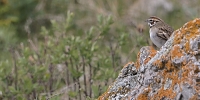
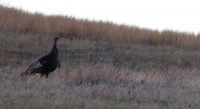 There are many birds, but the land is vast, and my time was limited. I saw several too far to photograph even with a 600mm lens (especially without a tripod). We saw bluebirds, red-tail hawks, sparrowhawks, buzzards, and dozens of other species, several of which I couldn’t identify. I saw a large gray owl along the road that I didn’t recognize, along with a medium-sized hawk that gracefully circled and hovered the same spot just feet off the ground.
There are many birds, but the land is vast, and my time was limited. I saw several too far to photograph even with a 600mm lens (especially without a tripod). We saw bluebirds, red-tail hawks, sparrowhawks, buzzards, and dozens of other species, several of which I couldn’t identify. I saw a large gray owl along the road that I didn’t recognize, along with a medium-sized hawk that gracefully circled and hovered the same spot just feet off the ground.
Mammals
Although North Dakota is relatively dry, it sustains a lot of large wildlife. Even the badlands make homes to all kinds of large animals.
Pronghorn
 One animal I had to see was the pronghorn. These majestic animals hang out on the prairie in areas where they can see long distances. They are made for speed as their prehistoric nemesis was the American cheetah (long extinct). When younger I saw a large group running together along the road. This time, they were all conserving their energy, casually grazing.
One animal I had to see was the pronghorn. These majestic animals hang out on the prairie in areas where they can see long distances. They are made for speed as their prehistoric nemesis was the American cheetah (long extinct). When younger I saw a large group running together along the road. This time, they were all conserving their energy, casually grazing.
Deer
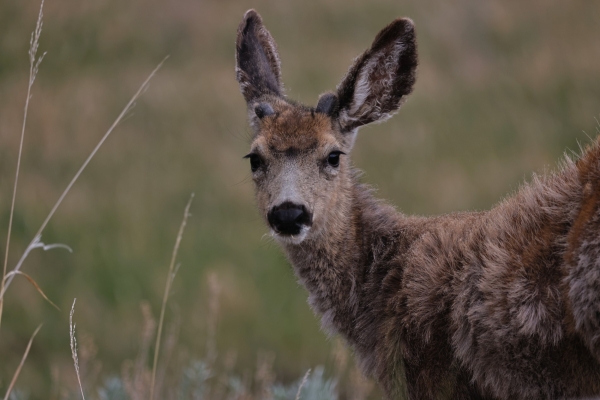 There are many species of deer in the area. White-tail deer are exceptionally common. We saw several groups along the roads despite the cooler temperatures. The fellow standing to eat made for some good photo-ops as he seemed to get frustrated and stomp frantically like a child throwing a temper tantrum before finally wondering off to find lower-hanging leaves.
There are many species of deer in the area. White-tail deer are exceptionally common. We saw several groups along the roads despite the cooler temperatures. The fellow standing to eat made for some good photo-ops as he seemed to get frustrated and stomp frantically like a child throwing a temper tantrum before finally wondering off to find lower-hanging leaves.
Bison
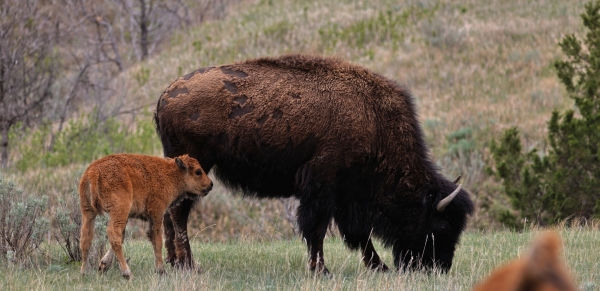 Although no longer common on the open prairie, bison do seem to be doing well in some areas like the Theodore Roosevelt National Park. Finding them among the backdrop of the badlands makes for some nice images; the abundance of calves was great to see.
Although no longer common on the open prairie, bison do seem to be doing well in some areas like the Theodore Roosevelt National Park. Finding them among the backdrop of the badlands makes for some nice images; the abundance of calves was great to see.
Prairie Dogs
 Farmers and ranchers don’t care much for prairie dogs because they create vast communities that pockmark the land with prairie potholes that are dangerous for livestock. Although bad for farmers, the critters are charismatic and fun to watch. There are several colonies near Medora that are easy to photograph.
Farmers and ranchers don’t care much for prairie dogs because they create vast communities that pockmark the land with prairie potholes that are dangerous for livestock. Although bad for farmers, the critters are charismatic and fun to watch. There are several colonies near Medora that are easy to photograph.
Wild Horses
My cousin Kent mentioned recently seeing a special site of wild horses and bison grazing alongside one another recently. We missed that opportunity, but we did get to see a heard of wild horses grazing at the top of the badlands near Medora.
Foxes
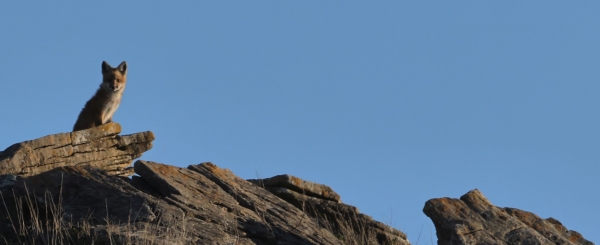 I expected to see some coyotes during our trip, but we only heard them. But we did see a den of their cousin the red fox. This little group of youngsters was hanging out on a hill just west of the town of Killdeer overlooking Highway 200.
I expected to see some coyotes during our trip, but we only heard them. But we did see a den of their cousin the red fox. This little group of youngsters was hanging out on a hill just west of the town of Killdeer overlooking Highway 200.
There are plenty of other critters in the area. I didn’t get to see any elk, big horn sheep, coyotes, weasel, badgers, beavers or porcupines.
Family
I was born in North Dakota but lived the bulk of my life in Ohio. Even so, there has always been a piece of me that felt close to North Dakota because of Dad. He told stories of growing up there, about the people of North Dakota. Those stories soaked into me as a kid, and there was always an allure of the simple life of country living. Although the country is vast and beautiful, it was the stories of the people that always made the place come alive as a home.
We arrived in time to celebrate my uncle Duane’s 80th birthday. I actually didn’t know the majority of the people at the small gathering when we arrived, but I felt embraced immediately. Duane’s grandkids filled up the large garage turned diner, running around happily. An old drill press served as a cup holder and a propane tank powered a makeshift heater, as it was cold that day. I marveled how much Duane reminded me of Dad. So many of their mannerisms were the same, down to little things they would say and how they said them. As a kid I didn’t think that Duane and Dad looked much alike, but they did look a lot more similar in their older years. Just being around him made me feel a little closer to my own dad; I tried as much as possible to pry some stories out of him about growing up. Of course, this showed one major difference between Dad and Duane—Dad could talk and talk. Duane is much more frugal with words and is often just matter-of-fact. For him, there isn’t much need to spend time thinking about the past, and his mind is mostly about today. Still, I got little pieces from him and other family.
I learned that Dad suffered malaria while serving in the military in Panama. While in the infirmary for several days he suffered hallucinations. One of those included a vision of Jesus; this started dad’s lifelong devotion to religion that progressively filled up the rest of his days. Religion is the primary subject that consumed my father during my life, and it covered up many of the things in Dad’s past. It was during an earlier trip to Killdeer that I learned Dad could play the mandolin banjo—as he only played the harmonica around me. And another surprise was that I reminded others of Dad in part because I was always carrying a camera—I didn’t know how much Dad had also been into photography. When he was older, I sometimes got him to go hiking with the cameras, but he never let on that he had been passionate about it in earlier years.
My Aunt Bonnie told me that Dad was always distracted from his chores by his obsession with wildlife. She said that Dad would stop milking their cow to look and listen when he heard particular birds; it was so repetitive, she said, that the cow eventually stopped giving milk whenever the birds would sing. It shows how much nature was always calling Dad. It’s a trait that he sent on down to me—which is one of the great enjoyments of North Dakota.
Hiking Up Old Baldy
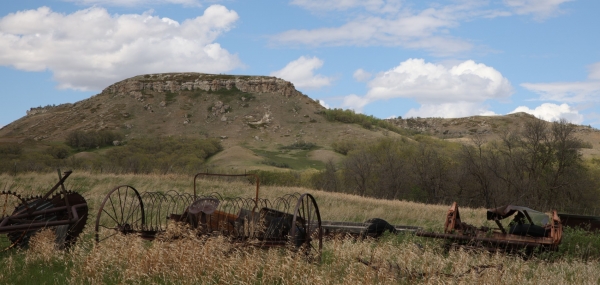 The last time I hiked Old Baldy, I was probably fifteen years old. It’s a distinct summit just north of my family’s farm. Last time we were here, a whole crowd of us hiked up there. But the current generations are not the same as the last—and I learned that many of these younger ones had never gone up there. This time, it was just Delwin and I.
The last time I hiked Old Baldy, I was probably fifteen years old. It’s a distinct summit just north of my family’s farm. Last time we were here, a whole crowd of us hiked up there. But the current generations are not the same as the last—and I learned that many of these younger ones had never gone up there. This time, it was just Delwin and I.
I must admit that I’m not fifteen anymore, and the climb was more challenging than I expected. But getting to the top was the highlight of my trip. The wind was strong and cold, but we were rewarded with grand views that stretched for miles into the vast distance. It was too cold to see blue racer snakes this time, but we saw several deer below us. It made me smile to think that I was trekking along a place that my dad had loved so deeply.
Saying Goodbye
Thirty years ago, I held a real camera for the first time and hiked the summit of a mountain to get a photo of a sunset. That first attempt was a failure. The photo didn’t come out at all, but the love it started in me has never waned.
On our final night I let some of the young kids play with one of my cameras, hoping to share with them a little spark of interest. It was my way of giving back just a little bit of the precious gift that Killdeer gave to me. I can only hope that someday they will look back with the same kind of fondness that I have for this place and the people.
As we drove away from the mountain, the sun was setting. I asked Delwin to stop the car to let me take one last photo of the trip. I finally got my sunset of the place. This time, the picture came out with a nice silhouette.
Something tells me it won’t be the last one I take of the place. And I don’t think I’m going to wait another thirty years to come back.
Note: Some photos of me on this page were taken by Delwin Olson and Hayden Olson.
- Stories from North Dakota
Some stories and thoughts related to North Dakota.
- The other end of life
- The Sunset and Spirits
- Donald George Olson died at 72
- Good Memories from the Badlands
- Adventures with Del


